You have an Azure Cosmos DB Core (SQL) API account that is configured for multi-region writes. The account contains a database that has two containers named container1 and container2.
The following is a sample of a document in container1:
{
"customerId": 1234,
"firstName": "John",
"lastName": "Smith",
"policyYear": 2021
}
The following is a sample of a document in container2:
{
"gpsId": 1234,
"latitude": 38.8951,
"longitude": -77.0364
}
You need to configure conflict resolution to meet the following requirements:
For container1 you must resolve conflicts by using the highest value for policyYear.
For container2 you must resolve conflicts by accepting the distance closest to latitude: 40.730610 and longitude: -73.935242.
Administrative effort must be minimized to implement the solution.
What should you configure for each container? To answer, drag the appropriate configurations to the correct containers. Each configuration may be used once, more than once, or not at all. You may need to drag the split bar between panes or scroll to view content.
NOTE: Each correct selection is worth one point.

You plan to create an operational system that will store data in an Azure Cosmos OB 'or NoSQL account. You need to configure the account to meet the following requirements:
•Support Spark queries.
•Support the analysis of data from the last six months.
•Only pay for analytical compute when running queries.
Which three actions should you perform? Each correct answer presents part of the solution. NOTE Each correct selection is worth one point.
You have a container in an Azure Cosmos DB for NoSQL account that stores data about orders.
The following is a sample of an order document.

Documents are up to 2 KB.
You plan to receive one million orders daily.
Customers will frequently view their past order history.
You are the evaluating whether to use order-Date as the partition key.
What are two effects of using order-Date as the partition key? Each correct answer presents a complete solution.
NOTE: Each correct selection is worth one point.
You have an Azure Cosmos DB for NoSQL account named account that has thedisablekeyBasedletadatwriteAccess property enabled.
You are developing an app named App1 that will be used by a use1 named DevUser1 to create containers in account1. DevUser1 has a non-privileged user account in the Azure AD tenant.
You need to ensure that DevUser1 can use App1 to create containers in account1.
What should you do? To answer, select the appropriate options in the answer area.
NOTE Each correct selection is worth one point.

Note: This question is part of a series of questions that present the same scenario. Each question in the series contains a unique solution that might meet the stated goals. Some question sets might have more than one correct solution, while others might not have a correct solution.
After you answer a question in this section, you will NOT be able to return to it. As a result1 these questions will not appear in the review screen.
You have a database in an Azure Cosmos DB for NoSQL account that is configured for multi-region writes.
You need to use the Azure Cosmos OB SDK to implement the conflict resolution policy for a container. The solution must ensure that any conflicts are sent to the conflicts feed.
Solution: You set ConflictResolutionMode to Laswriterwins and you use the default settings for the policy.
Does this meet the goal?
You have a container named container! in an Azure Cosmos DB for NoSQL account.
You need to provide a user named User1 with the ability to insert items into container1 by using role-based access The solution must use the principle of least privilege.
Which roles should you assign to User1?
You need to create a data store for a directory of small and medium-sized businesses (SMBs). The data store must meet the following requirements:
* Store companies and the users employed by them. Each company will have less than 1,000 users.
* Some users have data that is greater than 2 KB.
* Associate each user to only one company.
* Provide the ability to browse by company.
* Provide the ability to browse the users by company.
* Whenever a company or user profile is selected, show a details page for the company and all the related users.
* Be optimized for reading data.
Which design should you implement to optimize the data store for reading data?
You configure Azure Cognitive Search to index a container in an Azure Cosmos DB Core (SQL) API account as shown in the following exhibit.

Use the drop-down menus to select the answer choice that completes each statement based on the information presented in the graphic.
NOTE: Each correct selection is worth one point.

You have an Azure subscription. The subscription contains an Azure Cosmos DB for NoSQL account named account1 that hosts a container named Devices. Devices has a partition key named type.

You are evaluating the resource utilization of the query. How will the query be executed?
You have an Apache Spark pool in Azure Synapse Analytics that runs the following Python code in a notebook.
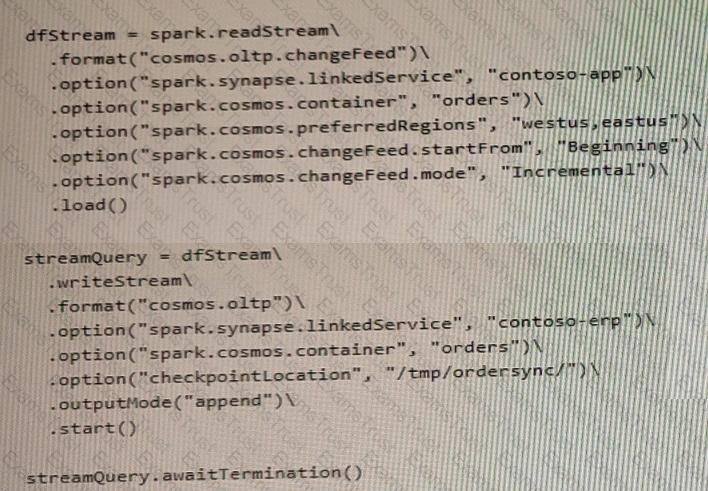
For each of the following statements, select Yes if the statement is true. Otherwise, select No.
NOTE: Each correct selection is worth one point.

You have an Azure subscription that contains an Azure Cosmos DB for NoSQL database named DB1. The shared throughput provisioned for DB1 is 10,000 DTU/s. DB1 contains the containers shown in the following table.

You need to modify the throughput for the containers. The solution must meet the following requirements:
• The maximum throughput for Container1 must be 4,000 DTU/s.
• The throughput for Contained must be shared across the containers.
• Administrative effort must be minimized.
What should you do? To answer, select the appropriate options in the answer area. NOTE: Each correct selection is worth one point.

You have an Azure Cosmos DB database that contains a container named container 1. The container1 container is configured with a maximum of 20,000 RU/s and currently contains 240 GB of data.
You need to estimate the costs of container1 based on the current usage.
How many RU/s will be charged?
You have the following query.
SELECT * FROM с
WHERE c.sensor = "TEMP1"
AND c.value < 22
AND c.timestamp >= 1619146031231
You need to recommend a composite index strategy that will minimize the request units (RUs) consumed by the query.
What should you recommend?
You have an Azure Cosmos DB Core (SQL) API account used by an application named App1.
You open the Insights pane for the account and see the following chart.
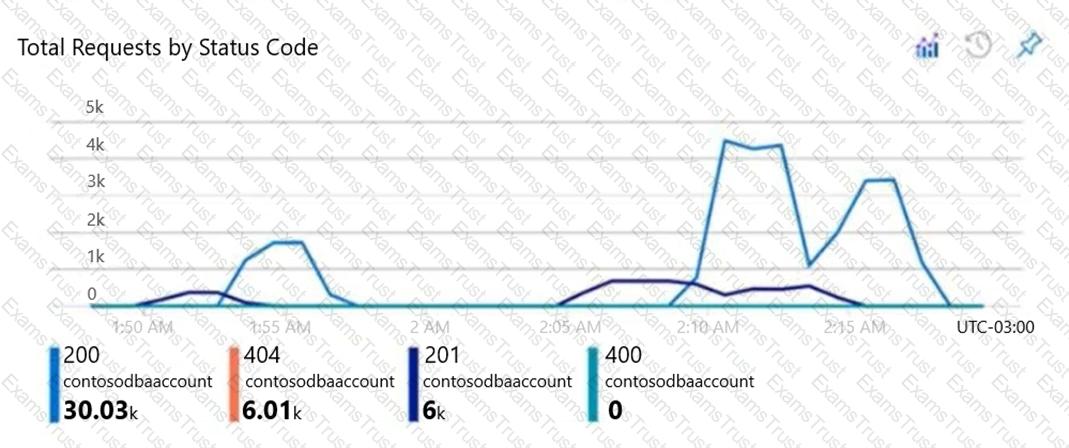
Use the drop-down menus to select the answer choice that answers each question based on the information presented in the graphic.
NOTE: Each correct selection is worth one point.
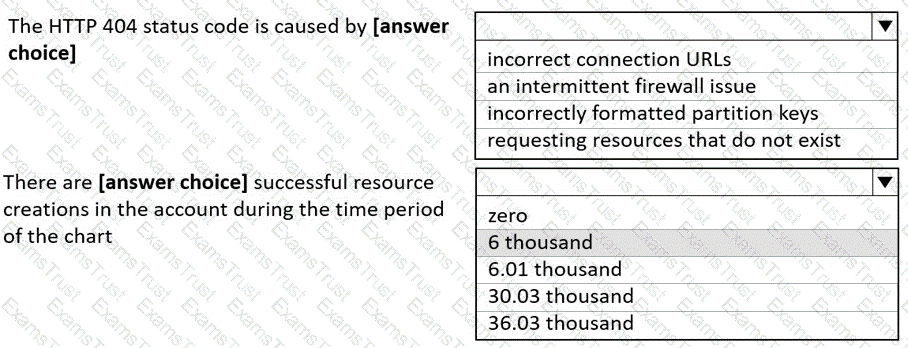
You have an app that stores data in an Azure Cosmos DB Core (SQL) API account The app performs queries that return large result sets.
You need to return a complete result set to the app by using pagination. Each page of results must return 80 items.
Which three actions should you perform in sequence? To answer, move the appropriate actions from the list of actions to the answer area and arrange them in the correct order.

You have an Azure Cosmos DB Core (SQL) API account that is configured for multi-region writes. The account contains a database that has two containers named container1 and container2.
The following is a sample of a document in container1:
{
"customerId": 1234,
"firstName": "John",
"lastName": "Smith",
"policyYear": 2021
}
The following is a sample of a document in container2:
{
"gpsId": 1234,
"latitude": 38.8951,
"longitude": -77.0364
}
You need to configure conflict resolution to meet the following requirements:
For container1 you must resolve conflicts by using the highest value for policyYear.
For container2 you must resolve conflicts by accepting the distance closest to latitude: 40.730610 and longitude: -73.935242.
Administrative effort must be minimized to implement the solution.
What should you configure for each container? To answer, drag the appropriate configurations to the correct containers. Each configuration may be used once, more than once, or not at all. You may need to drag the split bar between panes or scroll to view content.
NOTE: Each correct selection is worth one point.

You are creating a database in an Azure Cosmos DB Core (SQL) API account. The database will be used by an application that will provide users with the ability to share online posts. Users will also be able to submit comments on other users' posts.
You need to store the data shown in the following table.

The application has the following characteristics:
Users can submit an unlimited number of posts.
The average number of posts submitted by a user will be more than 1,000.
Posts can have an unlimited number of comments from different users.
The average number of comments per post will be 100, but many posts will exceed 1,000 comments.
Users will be limited to having a maximum of 20 interests.
For each of the following statements, select Yes if the statement is true. Otherwise, select No.
NOTE: Each correct selection is worth one point.
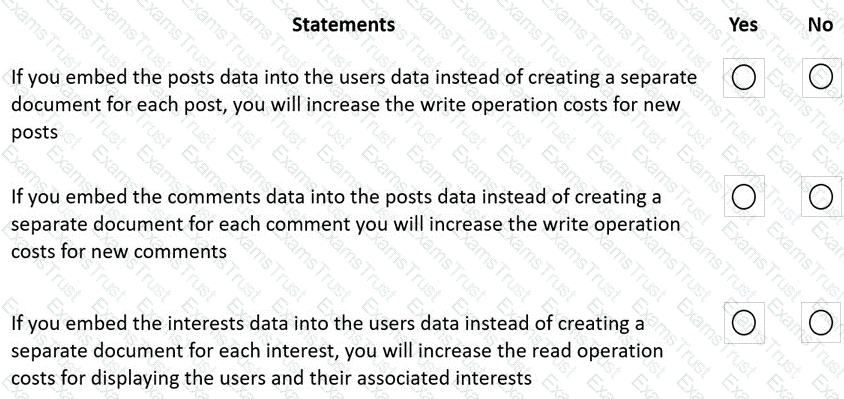
You need to configure an Apache Kafka instance to ingest data from an Azure Cosmos DB Core (SQL) API account. The data from a container named telemetry must be added to a Kafka topic named iot. The solution must store the data in a compact binary format.
Which three configuration items should you include in the solution? Each correct answer presents part of the solution.
NOTE: Each correct selection is worth one point.
You have a database named db1 in an Azure Cosmos DB for NoSQL
You are designing an application that will use dbl.
In db1, you are creating a new container named coll1 that will store in coll1.
The following is a sample of a document that will be stored in coll1.

The application will have the following characteristics:
• New orders will be created frequently by different customers.
• Customers will often view their past order history.
You need to select the partition key value for coll1 to support the application. The solution must minimize costs.
To what should you set the partition key?
You have an Azure subscription that contains an Azure Cosmos DB for NoSQL account named account1.
Backups for account1 have the following configurations:
• Interval: 2 hours
• Retention period: 4 days
You need to estimate the charges associated with the retention of the backups. How many copies of the backups will incur additional charges?
You have a container named container1 in an Azure Cosmos DB Core (SQL) API account. Upserts of items in container1 occur every three seconds.
You have an Azure Functions app named function1 that is supposed to run whenever items are inserted or replaced in container1.
You discover that function1 runs, but not on every upsert.
You need to ensure that function1 processes each upsert within one second of the upsert.
Which property should you change in the Function.json file of function1?
You maintain a relational database for a book publisher. The database contains the following tables.
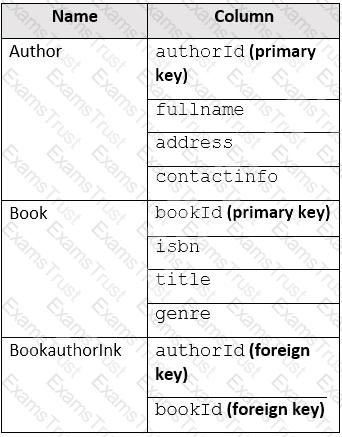
The most common query lists the books for a given authorId.
You need to develop a non-relational data model for Azure Cosmos DB Core (SQL) API that will replace the relational database. The solution must minimize latency and read operation costs.
What should you include in the solution?
You configure multi-region writes for account1.
You need to ensure that App1 supports the new configuration for account1. The solution must meet the business requirements and the product catalog requirements.
What should you do?
You need to provide a solution for the Azure Functions notifications following updates to con-product. The solution must meet the business requirements and the product catalog requirements.
Which two actions should you perform? Each correct answer presents part of the solution.
NOTE:Each correct selection is worth one point.
You need to recommend indexes for con-product and con-productVendor. The solution must meet the product catalog requirements and the business requirements.
Which type of index should you recommend for each container? To answer, select the appropriate options in the answer area.
NOTE: Each correct selection is worth one point.

You need to select the partition key for con-iot1. The solution must meet the IoT telemetry requirements.
What should you select?
You need to implement a solution to meet the product catalog requirements.
What should you do to implement the conflict resolution policy.
You need to identify which connectivity mode to use when implementing App2. The solution must support the planned changes and meet the business requirements.
Which connectivity mode should you identify?
You are troubleshooting the current issues caused by the application updates.
Which action can address the application updates issue without affecting the functionality of the application?
You need to select the capacity mode and scale configuration for account2 to support the planned changes and meet the business requirements. What should you select? To answer, select the appropriate options in the answer area. NOTE: Each correct selection is worth one point.
